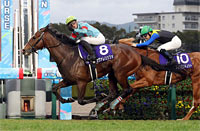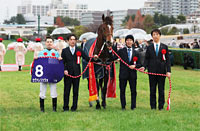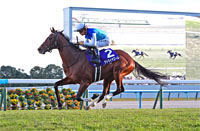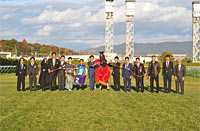Asahi Hai Futurity Stakes (G1) - Data Analysis
Clash between elite 2-year-olds that may provide hints about future big names
Although the Asahi Hai Futurity Stakes was moved from Nakayama Racecourse to Hanshin Racecourse in 2014, and the Hopeful Stakes (2,000m G1 race) was established in the final week of December in 2017, the Asahi Hai Futurity Stakes remains positioned as a decider for the year’s 2-year-olds. A victory in this race offers important hints for classic races in the following spring season. Let’s now analyze data from the last 10 years, including for the races held over the last five years at Hanshin Racecourse and those held previously at Nakayama Racecourse.
Last 10 winners all won previous race
Looking at runners over the last 10 years in terms of finish in their previous race, we find that the 10 winners all had finished “1st” in their previous race. Although the runners that had finished “1st” (83) and those that finished “2nd or lower” (80) in their previous race were more or less evenly distributed, runners in the group that had finished “1st” not only produced all winners but also dominated the Top 3. In the five years since the race was moved to Hanshin Racecourse, the group that had finished “1st” in the previous race delivered performance of [5-2-3-31] (Top 3 ratio of 24.4%), compared with [0-3-2-37] (Top 3 ratio of 11.9%) for the group that had finished “2nd or lower.” In other words, the group that had finished “1st” in the previous race remained dominant. [Table 1]
[Table 1] Performance by finish in previous race (last 10 years)
Finish in
previous race |
Performance
[1st-2nd-3rd-4th or lower] |
Win ratio |
Top 2 ratio |
Top 3 ratio |
| 1st |
10-5-8-60 |
12.0% |
18.1% |
27.7% |
| 2nd |
0-2-1-22 |
0% |
8.0% |
12.0% |
| 3rd |
0-0-1-7 |
0% |
0% |
12.5% |
| 4th |
0-1-0-7 |
0% |
12.5% |
12.5% |
| 5th |
0-0-0-8 |
0% |
0% |
0% |
| 6th-9th |
0-2-0-21 |
0% |
8.7% |
8.7% |
| 10th or lower |
0-0-0-8 |
0% |
0% |
0% |
| 2nd or lower |
0-5-2-73 |
0% |
6.3% |
8.8% |
Consecutive win experience is important
Looking at performances by runners over the last 10 years in terms of consecutive win experience, we observe that runners with experience of winning consecutive races produced seven winners. With the exception of one runner with only one career start, runners that did not have consecutive win experience produced two winners before 2013, when the race was still held at Nakayama Racecourse. Since the race was moved to Hanshin Racecourse, four of the five winners have been runners with consecutive win experience (with the fifth being 2015 winner Leontes, who had only one career start). [Table 2]
[Table 2] Performance by consecutive win experience (last 10 years)
Consecutive win
experience |
Performance
[1st-2nd-3rd-4th or lower] |
Win ratio |
Top 2 ratio |
Top 3 ratio |
| Yes |
7-4-5-52 |
10.3% |
16.2% |
23.5% |
| No |
2-6-5-78 |
2.2% |
8.8% |
14.3% |
| 1 career start |
1-0-0-3 |
25.0% |
25.0% |
25.0% |
Check favoritism in past races
Looking at performances by runners over the last 10 years in terms of lowest favoritism in past races, we note that eight of the 10 winners had a lowest favoritism of “1st favorite” or “2nd favorite.” In the five years since the race was moved to Hanshin Racecourse, three of the five winners had a lowest favoritism of “1st favorite,” the remaining two winners a lowest favoritism of “2nd favorite,” and runners with experience of contesting a race as 3rd favorite or lower produced zero winners. In other words, we should check favoritism in past races [Table 3]
[Table 3] Performance by lowest favoritism in past races (last 10 years)
Lowest
favoritism |
Performance
[1st-2nd-3rd-4th or lower] |
Win ratio |
Top 2 ratio |
Top 3 ratio |
| 1st favorite |
5-0-2-9 |
31.3% |
31.3% |
43.8% |
| 2nd favorite |
3-3-2-14 |
13.6% |
27.3% |
36.4% |
| 3rd favorite |
0-3-1-11 |
0% |
20.0% |
26.7% |
| 4th favorite |
0-0-2-13 |
0% |
0% |
13.3% |
| 5th favorite |
0-1-2-18 |
0% |
4.8% |
14.3% |
| 6th-9th favorite |
1-1-0-40 |
2.4% |
4.8% |
4.8% |
| 10th favorite or lower |
1-2-1-28 |
3.1% |
9.4% |
12.5% |
Watch number of wins in 1,500m+ races
Looking at performances by runners over the last 10 years in terms of the number of wins in 1,500m+ races, we find that all 10 winners had experience of winning a 1,500m+ race. In the five years since the race was moved to Hanshin Racecourse, four of the five winners (excluding Leontes, who had only one career start) had “2 or more wins” in 1,500m+ races, and four of the five runners-up also had experience of winning a 1,500m+ race. This suggests that experience of winning a 1,500m+ race is a key point. [Table 4]
[Table 4] Performance by number of wins in 1,500m+ race (last 10 years)
| Number of wins |
Performance
[1st-2nd-3rd-4th or lower] |
Win ratio |
Top 2 ratio |
Top 3 ratio |
| 3 wins or more |
1-1-0-1 |
33.3% |
66.7% |
66.7% |
| 2 wins |
5-3-5-26 |
12.8% |
20.5% |
33.3% |
| 1 win |
4-3-1-42 |
8.0% |
14.0% |
16.0% |
| 0 wins |
0-3-4-64 |
0% |
4.2% |
9.9% |
Seek out the winner!
Focus on distance of past races and career starts
Looking at performances by the five winners since 2014 (when the race was moved to Hanshin Racecourse) in terms of the distance of their past races (up to the previous race), we observe that all winners had exclusively entered turf 1,500m+ races in their past races. In addition, all five winners had four or fewer career starts. [Table 5]
[Table 5] Distance of past races contested by winners (last 5 years)
| Year |
Winner |
Previous race |
2 races back |
3 races back |
4 races back |
| 2014 |
Danon Platina |
Turf 1,600m |
Turf 1,600m |
Turf 1,500m |
|
| 2015 |
Leontes |
Turf 2,000m |
|
|
|
| 2016 |
Satono Ares |
Turf 1,600m |
Turf 1,800m |
Turf 1,800m |
Turf 1,800m |
| 2017 |
Danon Premium |
Turf 1,600m |
Turf 1,800m |
|
|
| 2018 |
Admire Mars |
Turf 1,600m |
Turf 1,600m |
Turf 1,600m |
|
(Michio Kawano)
|

- Preview
- Barrier draw
- Past performances of runners

- News
- Race result
- Video
- 2025 English

- 2024 English

- 2023 English

- 2022 English

- 2021 English

- 2020 English

- 2019 English

- 2018 English

- 2017 English

- 2016 English

- 2015 English

- 2014 English

- 2013 English

- 2012 English

- Photo Gallery
2025 Winner: Cavallerizzo


2024 Winner: Admire Zoom


|


















